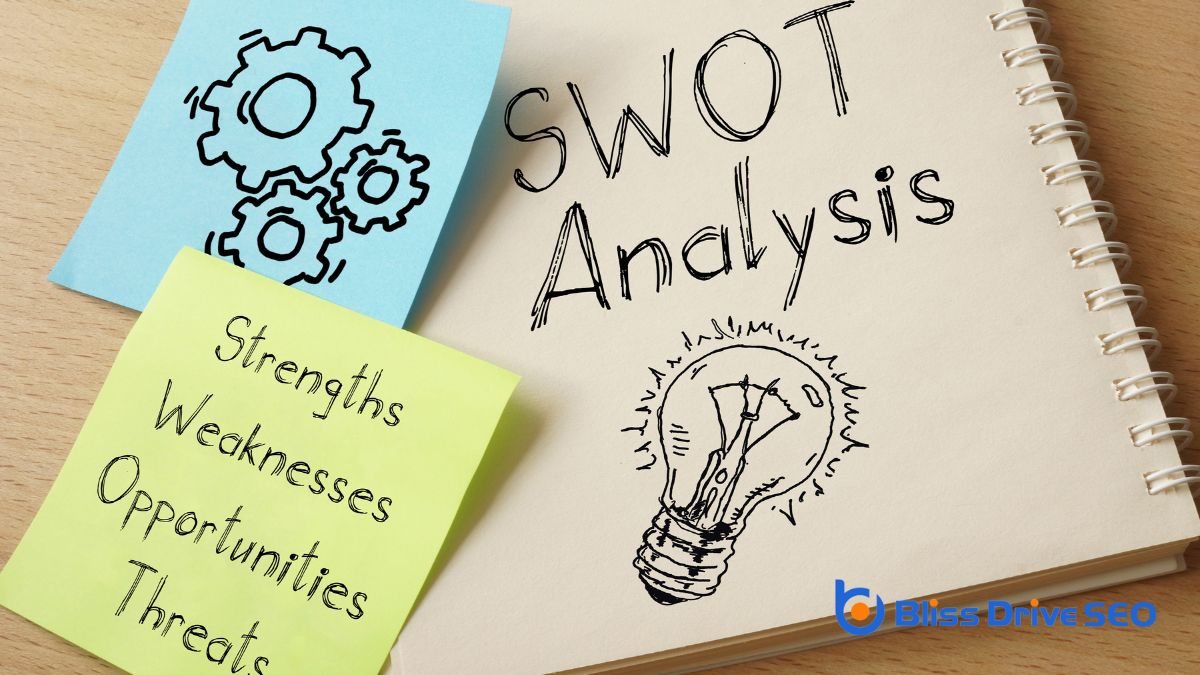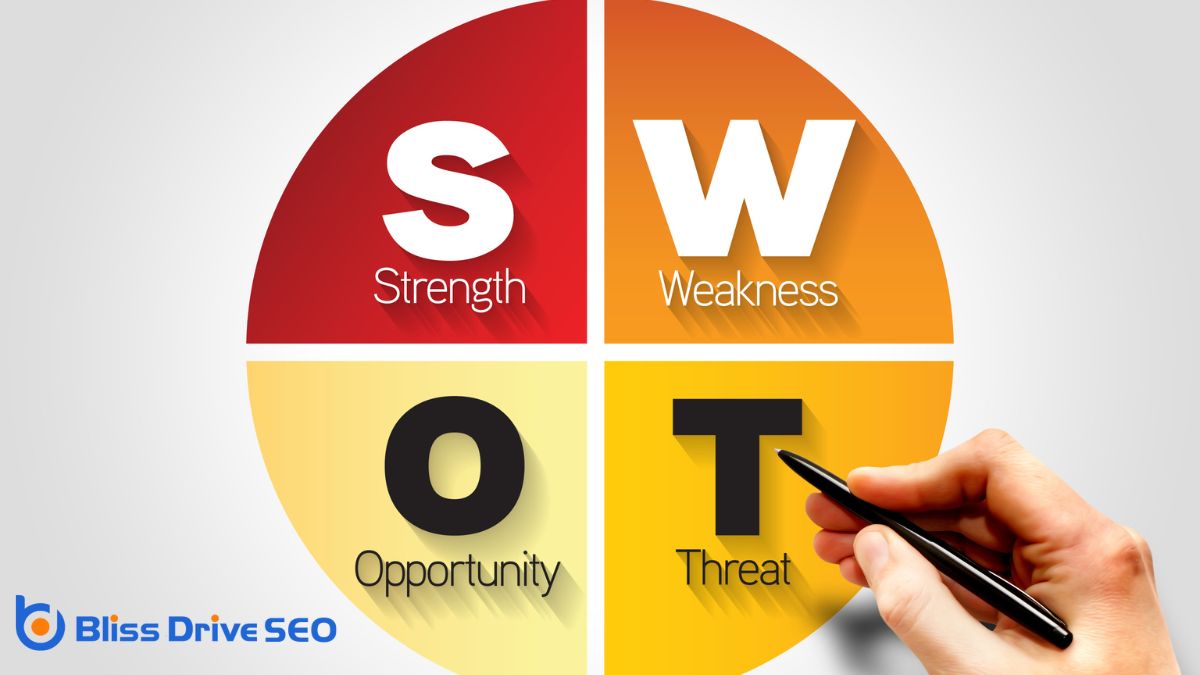Learn More About Us

To effectively conduct a SWOT analysis of a competitor, you start by pinpointing their unique strengths—those elements that set them apart in the marketplace. Don't overlook their weaknesses, as these can be pivotal in understanding where they might falter. Opportunities in the market can be your ally, helping you to foresee potential avenues for growth that your competitor hasn't tapped into yet. Meanwhile, threats loom large, demanding your attention. But how do you gather all this essential data and transform it into a strategic advantage for your business? There's more to uncover that could redefine your approach.

To truly grasp the SWOT framework, you should start by understanding its four key components: Strengths, Weaknesses, Opportunities, and Threats.
Strengths are positive attributes internal to an organization or individual that provide a competitive edge. They might include a strong brand, loyal customer base, or patented technology. Identifying strengths helps you recognize what advantages you or your competitors have in the marketplace.
Weaknesses, on the other hand, are internal factors that could hinder success. These might be gaps in expertise, limited resources, or outdated technology. Acknowledging weaknesses allows you to address them proactively, minimizing potential harm.
Opportunities are external factors that could be leveraged for growth or improvement. They often arise from market trends, technological advancements, or changes in consumer behavior. Recognizing opportunities enables you to capitalize on them before others do.
Threats, the final component, are external challenges that could jeopardize success. These might include new competitors, regulatory changes, or economic downturns. Understanding threats is essential for developing strategies to mitigate their impact.
Understanding the SWOT framework sets the stage for identifying competitor strengths, the first step in evaluating their position in the market. When you know what makes your competitors thrive, you gain insights into why they attract customers and how they maintain their edge.
To pinpoint these strengths, consider factors that contribute to their success. Start by examining their unique selling propositions. Ask yourself what differentiates them from others.
Look at their brand reputation; a strong brand can drive customer loyaltyThe likelihood of customers to continue purchasing from a brand over time. and trust. Evaluate their customer service; exceptional service often translates into repeat business and positive word-of-mouth.
Assess their market share; a large share indicates dominance and influence. Finally, consider their technological capabilities; cutting-edge tools and systems can streamline operations and enhance product offerings.
To recognize your competitor's weaknesses, start by identifying any gaps in the market they're unable to fill.
Next, analyze their resource limitations, which might hinder their ability to grow or innovate.
Finally, evaluate any strategic missteps they've made that could give you a competitive advantage.
Spotting competitor weaknesses is essential for identifying market gaps that your business can exploit. When you zero in on these weaknesses, you can find opportunities to differentiate your offerings and cater to unmet customer needs.
Start by examining where your competitors fall short, and look for areas they've overlooked or underserved. This requires keen observation and an analytical mindset.
To identify these gaps, consider the following:
Examining a competitor's resource limitations can reveal significant weaknesses that your business can exploit. Start by identifying where they fall short regarding finances, manpower, technology, or materials. If they're struggling with budget constraints, they might lack the capital to invest in new projects or marketing campaigns. This is your chance to capture market share by ramping up your efforts in those areas.
Look into their workforce. Are they understaffed or lacking in skilled employees? This can leadA potential customer referred by an affiliate who has shown interest in the product or service but h... to slower production times or poorer customer service. You can capitalize on this by ensuring your team is well-trained and adequately staffed, offering a better customer experience.
Technology is another critical area. If your competitor relies on outdated systems, they're likely inefficient. You can outpace them by adopting more advanced technology, leading to improved operations and customer satisfaction.
Additionally, check if they face supply chain issues. Limited access to materials can delay production, giving you an edge if your supply chain is robust and reliable.
While understanding a competitor's resource limitations lays the groundwork, it's equally important to assess their strategic missteps. These missteps can expose areas where they falter, providing you with valuable insights.
Start by identifying decisions that didn't go as planned. Did they launch a product that flopped? Or perhaps they entered a market too early or too late? These errors can illuminate weaknesses in their strategic approach.
Consider the following when evaluating their strategic missteps:
When exploring market opportunities, start by identifying untapped niches that your competitor hasn't addressed.
Keep an eye on emerging trends that could give you an edge, and assess where your competitor falls short.
To uncover untapped niches, focus on identifying gaps in the market where competitors have yet to establish a presence. Start by analyzing your competitor's offerings and pinpoint areas they overlook. Look for customer needs that aren't being met or problems that remain unsolved. By doing this, you'll gain insights into potential niches that can be targeted.
Consider the following strategies to identify untapped niches:
Once you've identified potential niches, analyze their viability. Evaluate the demand, potential competition, and resources required to successfully enter these markets.
Emerging trends offerThe specific product or service being promoted by affiliates. fertile ground for discovering new market opportunities. When you keep an eye on these trends, you can spot shifts in consumer preferences, technological advancements, and regulatory changes that might impact your industry. Analyzing these trends helps you anticipate the future and align your strategies accordingly.
It's essential to monitor industry reports, news articles, and social media buzz to get a sense of what's coming next.
To effectively analyze emerging trends, start by identifying the key drivers of change in your market. Are there new technologies being developed? Is there a shift in consumer behavior or preferences? By answering these questions, you gain insights into potential opportunities and threats.
Look at how your competitors are responding to these trends. Are they quick to adapt, or do they lag behind?
Additionally, consider trends outside your immediate industry. Sometimes, innovations in unrelated fields can spark ideas for new products or services.
Collaborate with your team to brainstorm how these trends could benefit your business. By staying informed and proactive, you position yourself to seize opportunities that others might overlook, giving you a competitive edge in the market.
Identifying competitor gaps can be a powerful strategy to uncover new market opportunities. By examining areas where your competitors fall short, you can position your business to meet unmet needs and capture a larger share of the market.
Start by analyzing competitor weaknesses in their products, services, or strategies. Look for patterns or trends that indicate potential areas for improvement or innovation.
To effectively assess these gaps, consider focusing on:

When analyzing potential threats, it's vital to remember that competitors can unexpectedly pivot and disrupt the market landscape. They might release innovative products or adopt new technologies that could render your offerings obsolete. Staying vigilant about industry trends and technological advancements is key.
You need to ask yourself: What are the emerging technologies or market trends that could pose a threat to your business?
Consider the possibility of regulatory changes that could favor your competitors. Competitors with better resources might lobby for favorable policies, affecting your market position. Keep an eye on political and economic changes that can impact your industry.
Another threat stems from shifts in consumer preferences. Competitors could capitalize on these changes faster than you, gaining a significant edge. Monitor consumer behavior and be ready to adapt.
Lastly, don't underestimate the power of competitors' strategic alliances. They might partner with other companies to enhance their market reach, which could encroach on your territory. Identifying potential partnerships in your industry is important to anticipating such moves.
To effectively gather relevant data, focus on the most impactful sources of information available. Start by identifying what you need to know about your competitor. This involves understanding their strengths, weaknesses, opportunities, and threats. Reliable data is essential, so tap into various resources that provide accurate insights.
Consider these key sources:
Exploring these resources will help you paint a clearer picture of your competitor's current standing and future trajectory. Be sure to look for patterns and anomalies that might indicate strategic shifts or underlying issues.
Also, don't just gather data—analyze it critically. This means looking beyond the numbers to understand the implications for your own business strategy. Remember, the aim is to derive actionable insights that inform your SWOT analysis.
After gathering extensive data about your competitor, the next step is turning these insights into a strategic plan. Start by identifying the most important strengths, weaknesses, opportunities, and threats that you've discovered. Prioritize them based on their impact on your business and relevance to your goals.
It's vital to focus on what can directly influence your strategy.
Now, consider how your business can leverage its strengths against the competitor's weaknesses. Create strategies that exploit these vulnerabilities. For example, if your competitor struggles with customer service, emphasize your superior support in your marketing efforts.
Simultaneously, address any threats you've identified. Develop contingency plans to mitigate risks, ensuring you're not caught off guard. If a competitor's strength poses a threat, brainstorm ways to neutralize it, such as enhancing your product features or offering better pricing.
Opportunities are goldmines. Use them to your advantage by aligning them with your business's capabilities. If a market gap exists, be the first to fill it.
Finally, set clear, measurable objectives. Assign responsibilities to team members, establish timelines, and track progress. An actionable plan isn't just a list; it's a roadmap to outperforming your competitor.
By understanding the SWOT framework, you can effectively analyze your competitors. Identify their strengths to know what you're up against, and pinpoint their weaknesses to find your advantages. Explore market opportunities that can be leveraged for your gain, and watch for potential threats to stay ahead. Gather all relevant data, and with these insights, create an actionable plan. This approach will help you enhance your market position and strategically outperform your competitors.
